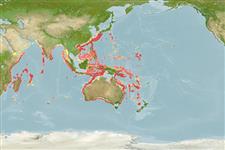Elasmobranchii (Haie und Rochen) (sharks and rays) >
Squaliformes (Sleeper and dogfish sharks) >
Centrophoridae (Gulper sharks)
Etymology: Centrophorus: centr[um] (L.), prickle or sharp point; phorus, from phoreus (Gr.), bearer or carrier, referring to grooved spines on dorsal fins. (See ETYFish); moluccensis: -ensis, Latin suffix denoting place: Moluccas Islands, Indonesia, type locality. (See ETYFish).
More on author: Bleeker.
Environment: milieu / climate zone / depth range / distribution range
Ökologie
seewasser bathydemersal; tiefenbereich 125 - 823 m (Ref. 247). Deep-water; 32°N - 40°S, 34°E - 171°E (Ref. 54313)
Indian Ocean: southern Mozambique and off Natal, South Africa (Ref. 5578); India (Ref. 31367). Western Pacific: Japan (Okinawa), Indonesia (Ambon), Philippines (Ref. 31367), Australia, New Hebrides, and New Caledonia.
Length at first maturity / Size / Gewicht / Alter
Maturity: Lm ?, range 80 - ? cm
Max length : 100.0 cm TL Männchen/unbestimmt; (Ref. 6871); max. veröff. Gewicht: 2.4 kg (Ref. 40637)
Rückenflossenstacheln (insgesamt): 2; Rückenflossenweichstrahlen (insgesamt): 0; Afterflossenstacheln 0; Afterflossenweichstrahlen: 0. A small, slender gulper shark with a long, narrow snout, a short-based 1st dorsal fin and a very small 2nd dorsal fin; pectoral rear tips elongated; denticles small and flat (Ref. 5578). Grayish brown dorsally, paler ventrally; fin of juveniles dark, with pale edges (Ref. 6577).
Found on the outer continental shelves and upper slopes, on or near the bottom (Ref. 247). Feeds on bony fish, as well as other dogfish sharks, squid, octopus, shrimp, and tunicates (Ref. 247). Ovoviviparous (Ref. 50449). Utilized as fishmeal (Ref. 31367), for its meat, fins (low value) and liver oil (very high value) (Ref.58048).
Ovoviviparous, embryos feed solely on yolk (Ref. 50449). Number of young 2 per litter; size at birth about 31 to 37 cm (Ref. 247); born at 35 cm TL (Ref.58048). Distinct pairing with embrace (Ref. 205).
Compagno, L.J.V., 1984. FAO Species Catalogue. Vol. 4. Sharks of the world. An annotated and illustrated catalogue of shark species known to date. Part 1 - Hexanchiformes to Lamniformes. FAO Fish. Synop. 125(4/1):1-249. Rome, FAO. (Ref. 247)
IUCN Rote Liste Status (Ref. 130435)
Bedrohung für Menschen
Harmless
Nutzung durch Menschen
Fischereien: weniger kommerziell
Mehr Information
ReferenzenAquakulturAquakultur ProfilZuchtlinienGenetikElectrophoresesVererbbarkeitKrankheitenVerarbeitungNutrientsMass conversion
Tools
Zusatzinformationen
Download XML
Internet Quellen
Estimates based on models
Preferred temperature (Ref.
123201): 9.3 - 18.5, mean 12.9 °C (based on 246 cells).
Phylogenetic diversity index (Ref.
82804): PD
50 = 0.5001 [Uniqueness, from 0.5 = low to 2.0 = high].
Bayesian length-weight: a=0.00263 (0.00121 - 0.00572), b=3.18 (2.99 - 3.37), in cm total length, based on LWR estimates for this (Sub)family-body shape (Ref.
93245).
Trophic level (Ref.
69278): 4.3 ±0.70 se; based on food items.
Widerstandsfähigkeit (Ref.
120179): sehr niedrig, Verdopplung der Population dauert mehr als 14 Jahre. (Fec=2).
Fishing Vulnerability (Ref.
59153): High vulnerability (60 of 100).
Nutrients (Ref.
124155): Calcium = 7.21 [1.39, 38.02] mg/100g; Iron = 0.313 [0.073, 1.003] mg/100g; Protein = 19.8 [17.5, 22.0] %; Omega3 = 0.287 [0.103, 0.899] g/100g; Selenium = 14.4 [4.6, 42.6] μg/100g; VitaminA = 13.6 [2.9, 63.5] μg/100g; Zinc = 0.29 [0.14, 0.56] mg/100g (wet weight);
